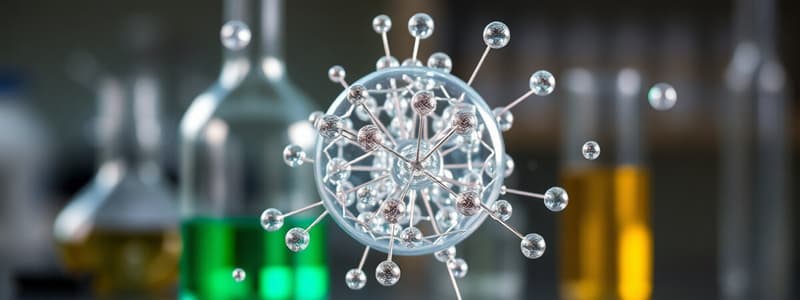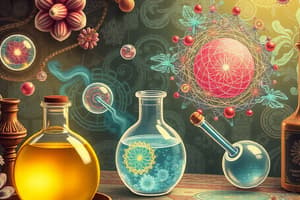Podcast
Questions and Answers
Which of the following is NOT a physical property?
Which of the following is NOT a physical property?
- Solubility
- Malleability
- Flammability (correct)
- Mass
Which of the following is a characteristic of a heterogeneous mixture?
Which of the following is a characteristic of a heterogeneous mixture?
- Uniform composition throughout
- Contains only one type of substance
- Components are easily separated
- Components can be distinguished visually (correct)
What is a chemical property that describes how readily a substance reacts with oxygen?
What is a chemical property that describes how readily a substance reacts with oxygen?
- Toxicity
- Reactivity (correct)
- Acidity
- Solubility
Which of the following is an example of a chemical change?
Which of the following is an example of a chemical change?
Which of these is a quantitative property?
Which of these is a quantitative property?
In the chemical word equation 'Potassium hydroxide + sulfuric acid → potassium sulfate + water', what are potassium hydroxide and sulfuric acid considered?
In the chemical word equation 'Potassium hydroxide + sulfuric acid → potassium sulfate + water', what are potassium hydroxide and sulfuric acid considered?
Which gas test relies on the gas turning limewater cloudy?
Which gas test relies on the gas turning limewater cloudy?
Which of the following is NOT a periodic table trend?
Which of the following is NOT a periodic table trend?
What is the primary purpose of making observations?
What is the primary purpose of making observations?
Which statement correctly describes a compound?
Which statement correctly describes a compound?
What differentiates pure substances from mixtures?
What differentiates pure substances from mixtures?
Which of the following is true about solutions?
Which of the following is true about solutions?
What role does the Particle Theory of Matter play in chemistry?
What role does the Particle Theory of Matter play in chemistry?
How can a compound be broken down into simpler substances?
How can a compound be broken down into simpler substances?
What defines a homogeneous mixture?
What defines a homogeneous mixture?
What is the purpose of using pure substances in chemical reactions?
What is the purpose of using pure substances in chemical reactions?
What distinguishes isotopes of an element from one another?
What distinguishes isotopes of an element from one another?
What is the charge of a neutron?
What is the charge of a neutron?
Which particle is located outside the nucleus of an atom?
Which particle is located outside the nucleus of an atom?
What is the purpose of a Bohr Rutherford diagram?
What is the purpose of a Bohr Rutherford diagram?
What does standard atomic notation provide about an atom?
What does standard atomic notation provide about an atom?
What defines a stable ion?
What defines a stable ion?
What is the mass of an electron?
What is the mass of an electron?
What is a neutral atom?
What is a neutral atom?
Flashcards
Observation
Observation
The process of using senses to gather information about objects, places, or events.
Inference
Inference
The process of drawing conclusions or making assumptions based on available information.
Pure Substance
Pure Substance
A substance composed of only one type of particle and has a fixed structure.
Mixture
Mixture
Signup and view all the flashcards
Solution
Solution
Signup and view all the flashcards
Compound
Compound
Signup and view all the flashcards
Homogeneous Mixture
Homogeneous Mixture
Signup and view all the flashcards
Particle Theory of Matter
Particle Theory of Matter
Signup and view all the flashcards
Element
Element
Signup and view all the flashcards
Heterogeneous Mixture
Heterogeneous Mixture
Signup and view all the flashcards
Physical Change
Physical Change
Signup and view all the flashcards
Chemical Change
Chemical Change
Signup and view all the flashcards
Physical Property
Physical Property
Signup and view all the flashcards
Chemical Property
Chemical Property
Signup and view all the flashcards
Reactant
Reactant
Signup and view all the flashcards
Product
Product
Signup and view all the flashcards
What is a Subatomic particle?
What is a Subatomic particle?
Signup and view all the flashcards
What is a Proton?
What is a Proton?
Signup and view all the flashcards
What is a Neutron?
What is a Neutron?
Signup and view all the flashcards
What is an Electron?
What is an Electron?
Signup and view all the flashcards
What is a Bohr Rutherford diagram?
What is a Bohr Rutherford diagram?
Signup and view all the flashcards
What is a Neutral atom?
What is a Neutral atom?
Signup and view all the flashcards
What is an Isotope?
What is an Isotope?
Signup and view all the flashcards
What is Standard atomic notation?
What is Standard atomic notation?
Signup and view all the flashcards
Study Notes
Chemistry Study Notes
- Observations vs. Inferences:
- Observation: Using senses to learn about objects, events, and their properties.
- Inference: Drawing conclusions based on evidence and reasoning.
- Observations are used to collect data for developing and testing hypotheses.
- Inferences explain phenomena using data.
Particle Theory
- Particle Theory of Matter: All matter is made up of tiny indivisible particles.
- Particles are too small to be seen.
- This theory explains matter's behaviour.
Pure Substances vs. Mixtures
- Pure Substances: Made of only one type of particle; have a fixed structure.
- Used to measure properties accurately and for chemical reactions without impurities.
- Mixtures: Combinations of two or more substances in varying proportions.
- Used in many everyday processes, like cooking, cleaning, and medicine.
Solutions
- Solutions: Homogeneous mixtures of two or more substances.
- Used to separate and purify materials, and to carry out chemical analysis.
Compounds
- Compounds: Substances made of two or more different elements combined in a fixed ratio.
- The elements react and form strong bonds.
- Requires significant energy to break apart.
- Difference between pure substances and mixtures lies in how the components are joined
Homogeneous vs. Heterogeneous Mixtures
- Homogeneous Mixture: Uniform composition throughout the mixture.
- Heterogeneous Mixture: Non-uniform composition throughout the mixture.
- Mechanical Mixture: Two or more particle types not mixed evenly.
Physical and Chemical Properties
- Physical Property: Characteristic observed and measured without changing substance identity.
- Used to describe changes in momentary states.
- Chemical Property: Characteristic observed during a chemical reaction.
- Used for building chemical classifications.
Examples of Properties
- Physical properties: Colour, Hardness, Malleability, Weight, Electrical Conductivity, Solubility, Mass
- Chemical properties: Flammability, Toxicity, Acidity, Reactivity, Heat of Combustion
Quantitative and Qualitative Properties
- Quantitative Property: Measured and described with numbers
- Qualitative Property: Observed but not numerically measured.
Physical vs. Chemical Change
- Physical Change: Change in physical properties, not changing the substance's identity.
- Chemical Change: Change in materials to form new substances with different properties.
Testing for Unknown Gases
- Oxygen: Relights a glowing splint
- Hydrogen: Causes a lit splint to burn with a 'squeaky pop'.
- Carbon Dioxide: Turns limewater cloudy
Chemical Word Equations
- Reactants: Starting materials written on the left side of the equation.
- Products: Results of the reaction, written on the right side of the equation
Periodic Table Trends
- Patterns in the periodic table showing aspects of elements (size, electronic properties).
- Used to predict element properties.
Subatomic Particles
- Subatomic Particles: Particles smaller than an atom
- Charge, Mass, and Spin
- Types: Electrons (-), Protons (+), Neutrons (0)
- Location: Electrons (outside nucleus), Protons & Neutrons (inside nucleus).
- Mass values for each particle
- Charge values for each particle
Bohr-Rutherford Diagrams
- Model for visualizing electrons orbiting the nucleus.
Neutral Atoms
- Atoms with no net electric charge (equal number of protons and electrons).
Isotopes
- Variations of an element with the same number of protons but different number of neutrons.
Standard Atomic Notation
- Way to represent atoms with element symbol, mass number, and atomic number.
- Used to show important information about an atom, like its element, number of protons, and total number of protons and neutrons. It helps identify different isotopes of the same element.
Chemical Formulas
- Represent substances using symbols and numbers, showing the elements and the number of atoms.
- Used to describe the composition of a chemical substance.
Binary Ionic Compounds
- Compounds composed of a metal cation and a nonmetal anion held together by ionic bonds.
Studying That Suits You
Use AI to generate personalized quizzes and flashcards to suit your learning preferences.
Related Documents
Description
Explore the fundamental concepts of chemistry, including observations vs. inferences, the particle theory of matter, and the distinction between pure substances and mixtures. This quiz will test your understanding of these core topics, essential for mastering chemistry.




